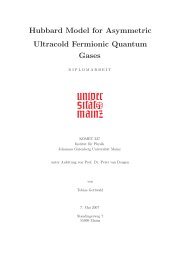5 Hirsch-Fye quantum Monte Carlo method for ... - komet 337
5 Hirsch-Fye quantum Monte Carlo method for ... - komet 337
5 Hirsch-Fye quantum Monte Carlo method for ... - komet 337
Create successful ePaper yourself
Turn your PDF publications into a flip-book with our unique Google optimized e-Paper software.
5.22 Nils Blümer<br />
1<br />
0.8<br />
0.6<br />
Z<br />
0.4<br />
0.2<br />
0<br />
0.25<br />
0.2<br />
0.15<br />
D<br />
0.1<br />
0.05<br />
0<br />
E<br />
0.4<br />
0.2<br />
0<br />
-0.2<br />
-0.4<br />
-0.6<br />
-0.8<br />
0 1 2 3 4 5 6<br />
U<br />
T=0.1<br />
E pot<br />
E tot<br />
E kin<br />
2OPT: T=0<br />
Fig. 13: Quasiparticle weightZ (discrete estimate), double occupancyD, and energy contributions<br />
<strong>for</strong> the 1-band Hubbard model on the Bethe lattice (bandwidthW = 4) at T = 0.1 in the<br />
paramagnetic phase. Crosses (connected with lines) denote QMC results <strong>for</strong>∆τ = 0.2, squares<br />
are <strong>for</strong> ∆τ = 0.125. For comparison, results of second order perturbation theory (2OPT) are<br />
shown <strong>for</strong> the total energy and the double occupancy <strong>for</strong>T = 0 (solid black lines).<br />
metal-insulator transition so that its interpretation as a quasiparticle weight breaks down. In<br />
contrast, the discrete version (41) always leads to positive Z and may there<strong>for</strong>e appear more<br />
physical. In any case, Z loses its theoretical foundation outside the Fermi liquid phase where<br />
it remains only a heuristic indicator of a metal-insulator transition. In the uppermost part of<br />
Fig. 13, Z is shown <strong>for</strong> the relatively high temperature T = 0.1. A rapid change of slopes<br />
indicates a transition or crossover near U ≈ 4.7.<br />
Energy<br />
Within the DMFT, the energy per lattice site is given as [1, 8]<br />
�<br />
E = lim<br />
η→0 +T<br />
n,σ<br />
� ∞<br />
e<br />
dǫ<br />
iωnη ǫρ(ǫ)<br />
iωn −ǫ−Σσ(iωn)<br />
−∞<br />
1 �<br />
+ T Σσ(iωn)Gσ(iωn). (42)<br />
2<br />
n,σ













